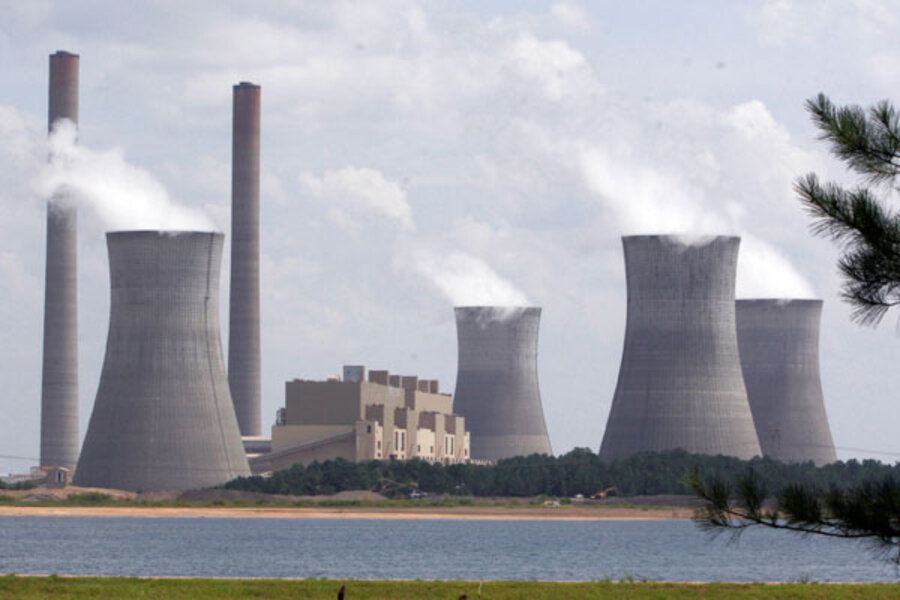'50 dirtiest' US power plants emit more greenhouse gases than South Korea
Loading...
Fifty US power plants emit more greenhouse gases from burning fossil fuels than all but six nations, says a new report.
The study by Environment America paints a bulls-eye on the nation’s biggest coal-fired power plants, suggesting that reining in a relatively small share of America's 6,000 electric generating facilities could have a significant impact on greenhouse gas emissions.
The report comes as the Obama administration is preparing the nation’s first-ever greenhouse gas emissions regulations for US power plants, which could be released as soon as this month. The administration’s goal is to have power plant emissions regulations in place by 2015, and the new study provides a window into which plants could face steep federal fines unless they slash emissions or close.
Of the country's 6,000 coal, oil, natural gas, nuclear, wind, and solar electric-generating facilities, a small sub-group of mostly coal-fired power generators produces more than its share of the nation’s carbon dioxide (CO2) emissions compared with the electricity it produces, the report found. The "50 dirtiest" power plants generated nearly 33 percent of the US power sector's carbon dioxide emissions in 2011 but only about 16 percent of its electricity.
US power plants are the largest source of greenhouse gases in the country, responsible for 41 percent of the nation’s carbon dioxide pollution, the report states. But the "50 dirtiest" stand out for emitting more than 2 percent of the world’s energy-related carbon dioxide pollution – which would place them at No. 7 if they were a country, behind Germany and ahead of South Korea.
The top CO2-emitting power plant in the US – Power Plant Scherer in Juliette, Ga. – produced more than 21 million metric tons of carbon dioxide in 2011, a greater total than all of Maine. Ninety-eight of the nation’s 100 most-polluting power plants in terms of total carbon dioxide emissions are coal plants, the study found.
The report, like others, points to low-hanging fruit. Cleaning up even a few power plants could have an outsize environmental effect, the report's authors say.
“America's dirtiest power plants are the elephant in the room when it comes to global warming," said Julian Boggs, global warming program director at Environment America Research & Policy Center, in a statement. "If we want a cleaner, safer future for our kids, we can't afford to ignore power plants' oversized contribution to global warming.”
Congressional supporters hailed the report as contributing a new perspective on an old problem.
“As carbon pollution continues to compromise public health and wreak havoc on our atmosphere and oceans, this report shines a spotlight on the biggest culprits – power plants,” said Sen. Sheldon Whitehouse (D) of Rhode Island.
Utility industry officials say they're already making major efforts to cut traditional pollution emissions, such as sulfur dioxide and nitrous oxide. The Southern Company, whose subsidiary, Georgia Power, owns Plant Scherer, is spending billions to upgrade Scherer’s antipollution systems, a spokesman says.
“Georgia Power and Plant Scherer comply with all standards for air and water quality that are set by the US Environmental Protection Agency and Georgia Environmental Protection Division,” says Mark Williams, a company spokesman, in an e-mail.
As for greenhouse gas emissions, the company is conducting research into “carbon capture” that could store CO2 underground, he writes. It is also building an advanced coal-fueled plant in Mississippi that is expected to have greenhouse gas emissions on par with a natural gas-fired plant of the same generating capacity.
But “there are currently no demonstrated technologies to control CO2 emissions from large coal-fired power plants such as Scherer,” Mr. Williams notes.
The industry hopes to work with the administration and Congress “to forge workable regulations,” said Thomas Kuhn, president of the Edison Electric Institute, a trade group representing investor-owned utilities, in June.
Whether that will be enough to save massive power plants like Scherer remains to be seen. President Obama in a June speech declared his administration would plow ground on air regulations to curb climate change. The administration has the authority to regulate greenhouse gas emissions under the Clean Air Act.
“We don't have time for a meeting of the flat-earth society,” Obama said. “Sticking your head in the sand might make you feel safer, but it's not going to protect you from the coming storm. And ultimately, we will be judged as a people and as a society and as a country on where we go from here.”








